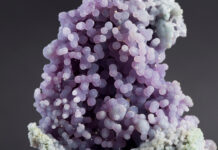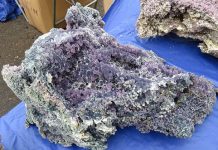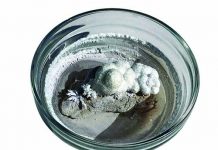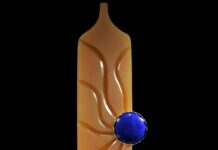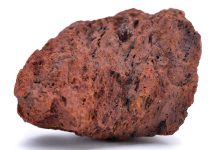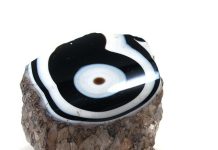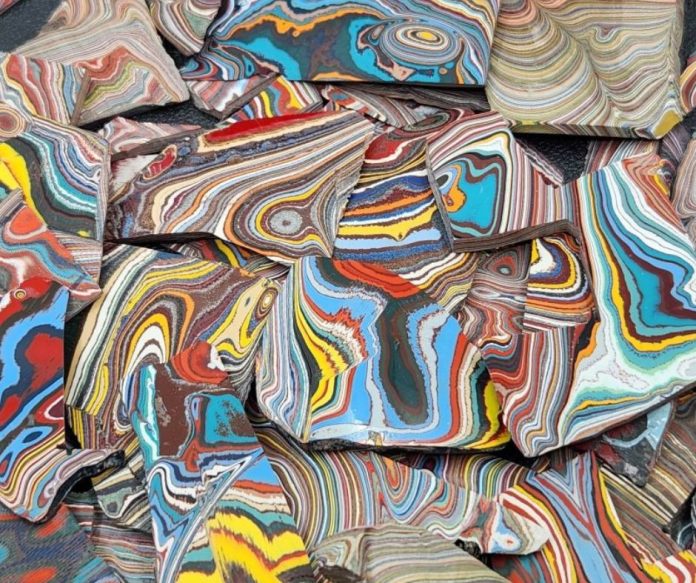
Fordite is a man-made gemstone that can be best described by Bob Ross, who once said, “We don’t make mistakes, just happy little accidents.” Also known as “Detroit agate” and “Motor City agate,” the material is not a rock, but rather, the buildup of paint overspray baked over time on the walls and assembly stands in manufacturing plants, mainly in Michigan, such as Ford, Chrysler, General Motors, Kenworth trucks and Jeep.
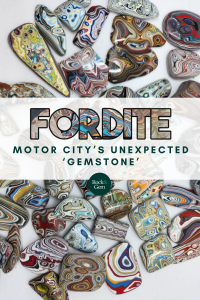
How Fordite Was Made
Originally discarded when the layers of paint grew so thick that they hindered pulling the automobiles into the bays, workers later discovered the paint slag hardened into colorful works of art and started recovering it. Enthusiasts today scavenge it from abandoned factories and scour the internet and garage sales, ultimately creating a market that’s expanded to include Fordite jewelry, key chains, cuff links, money clips, knife handles, magnets, pens and more.
Some of the finest Fordite pieces contain inorganic lead, which is not easily absorbed through the skin. The federal government banned the use of lead-based paint for consumer purposes in 1978. In the mid-80s, automated car painting was introduced. Today, the chassis is charged to attract the paint molecules, so there is practically no waste. The primary way to obtain new Fordite is from private car shops or plants that use slave cars, which are vehicles outfitted with parts that need to be painted.
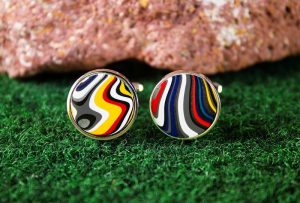
How to Tell the Age of Fordite
“There are several different types of Fordite, some having separated colors and regular banding with a primer layer in between, while others are color-on-color with metallic and limited color ranges. Add in the color from drips and swirls, most likely from the walls and floor of the paintings’ rooms, and you have very neat patterns,” explains retired artisan Joan Madouse.
Experts can usually tell the age of the Fordite and where it came from based on a variety of factors.
“Older Fordite is in the shape of stalactites, while modern is mostly all flat because it doesn’t have lead in it,” says Detroit-based Cheryl Hoeneise, owner of Northern Lights Fordite. “I have a catalog of car paint codes from dealerships to get a good idea. Chevys from 1954-56 are easy colors for me to identify.”
Fordite’s Hidden Secrets
Fordite roughs are unlikely to excite the average person, but those skilled with cutting and polishing it know its hidden secrets.
“Fordite has different patterns depending on how you cut it. Bumps on the outside will yield beautiful orbital patterns just under the surface. Deeper cuts will reveal stripes,” Hoeneise points out. “When I was a kid, all the males in our family worked at the Cadillac plant, so I could have made out like a bandit if I’d known about Fordite then.”
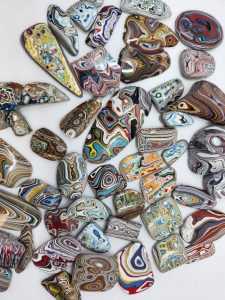
(Cheryl Hoeneise)
She recommends wearing a mask and gloves when cutting into Fordite to protect against inhaling any particles. Every time she puts a piece through the grinder, it changes.
“There are six wheels on the grinder that make it finer and finer and finer. You get more patterns as you go through each one of the wheels. Each one looks better than the rest. You have to learn when to stop,” she says.
Caring for Fordite
While Fordite is appropriate for everyday wear, care must be shown. If it were judged using the Mohs scale of hardness, it would sit between a 4 and 5.
“It’s harder than sandstone and much like Petoskey stones. Those with veneer are almost diamond strength and are hard to work with,” she adds. “You can use a little wax to shine it up, but never use jewelry cleaner.”
She applies Super Cerium to finished pieces, which is a high-grade polishing compound. No two pieces of Fordite are exactly the same. Because of that, some jewelry makers work to ensure very little of it gets covered up.
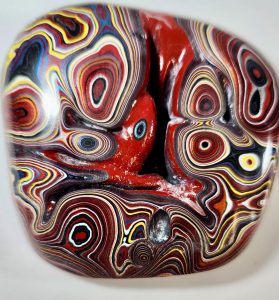
Chuck Martin, owner of Drummond Island Rocks, based in Sterling Heights, Michigan, groove-wraps his pieces.
“I mill a channel all the way around the cabochon and then inset the sterling silver wire. It is a very secure setting that does not cover up any of the cabochon,” he explains
Fordite: Vintage Favorites
Todd Farnum, with Motorcity Fordite out of Detroit, owned a piece of Fordite without even knowing what it was.
“I did some research back in 2014. A friend said I needed to start grabbing what I could,” he says. “I have a background as an electrician, in art and auto body repair, so I experimented with shapes. If I wanted to reveal different layers, I could just wet sand it and polish.”He favors specimens from the 1950s and 60s.
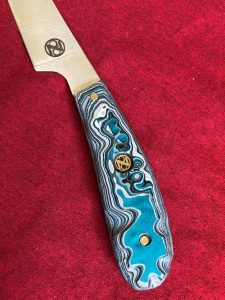
(TC Merritt)
“The modern stuff isn’t as durable or colorful. Any plant that used lacquer back in the day is always the most desirable, because with lacquer, or even some of the baked enamels, it’s hard enough that you can cut it with a band saw. Those sources are pretty much gone unless you know a custom painter, but it takes a long time for a small business to accumulate enough layers where it’s able to be cultivated.”
Farnum adds that if you’re looking for Fordite that contains higher impact hues, you’ll find that with the muscle cars. It’s hard to beat the shiny metallic silver from the Ford Mustang circa 1984-86. Fordite from Ohio-based van manufacturers tends to be earth tones of green and brown or flower child shades of yellow, orange and bright blues. Corvette Fordite hails from Bowling Green, Kentucky, and says Hoeneise, is the most amazing variety she’s encountered.
“It has a lot of metallics. It’s a different kind of paint. I think it has a different formula. You can really tell when something is a Corvette. It just hits you,” she says. “When you see it, you’ll see a lot of gold and silver and blue and things that don’t look like a Jeep or a truck.”
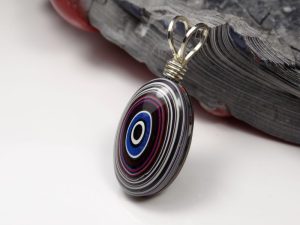
(Chuck Martin)
Hitting the Bullseye
Not all Fordite contains swirls and banding. Some resemble bullseyes, as is common with Jeep Fordite, also known as Jeepite.
“The bullseye patterns are a result of any Fordite that is collected in flat sheets,” Martin notes. “I have flat sheets of Jeep material and other brands as well. The layers of paint are all uniform thickness and all parallel to each other which lends itself to the bullseye effect when domed. The random patterns are found in the gnarly pieces that used to come off of the tubing of the paint racks. Those pieces were always random shapes with a lot of dripping.”
Knowing What You Buy
Unless you’ve personally sourced Fordite, it can be difficult to confirm its age and origins. TC Merritt of ZenfinityDesigns, based in Grand Haven, Michigan, gathers the rough materials himself for use in jewelry and Fordite-handled knives.
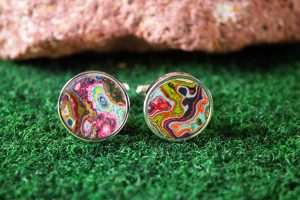
(Howard Stern)
“I get permission from a pair of Ford engineer friends whose job is to ensure safety and act as liaison to the EPA, etc, securing old factory sites to make sure the old paint isn’t leeching into the ground,” he says. “Long story short, they are my verification method for almost all my Ford Mustang Fordite, all of it pre-1996, from three sites here in the Midwest: one in Ohio and two in Michigan. We know it’s largely Mustang because of the records kept by Ford on each timeframe and when the spray booths closed.”
Merritt adds that Mustang Fordite has brighter colors, sharper cuts and the weight of the raw chunks is noticeable.
Fake pieces made overseas have wider paint layers than the real deal. The colors may also be too bright and make you question when a car was ever painted that shade (it wasn’t).
Another product sold alongside Fordite is called Cadillac Ranch. It is a soft man-made material that comes from the roadside attraction and art installation at Cadillac Ranch in Amarillo, Texas, founded in 1974. Visitors are welcome to take spray paint and leave their mark on the discarded, buried cars. The sun then hardens the paint.
“Cadillac Ranch won’t have defined colors — they run into each other,” says Howard Stern, who sells Fordite cuff links and key chains out of Scottsdale, Arizona. “I don’t like working with it because it falls apart very quickly and is not baked after each coating.” The Corvette rough he works with is from the 2000s, while his 1970s and early 80s pieces originate from the GM assembly plant in Flint, Michigan.
10 Fordite Classifications
Hoeneise classifies her Fordite rough in the following ways:
1. Specimens
Large, rare collectible pieces that are usually finished and polished. One-of-a-kind beauties.
2. Chips
Small pieces of Fordite leftover from larger projects. Very useful for creating mosaics, accents, and embedding in resin.
3. Trims
These are pieces left over from cutting pieces to create jewelry insets. They tend to be small and thinner than a mini slab, but are very useful for creating mosaics, accents, and filling shallow jewelry bezels.
4. Veneer Slabs
Thin slabs suitable for inlay or mosaic work. Not suitable for cabochon work.
5. Mini Slabs
Larger and usually thicker than trims. Generally from 1/8 inch to 1/6 inch thickness, but not always. Great for creating shapes to fill flat jewelry bezels. Not necessarily a uniform thickness from end to end; tapering may occur.
6. Slabs
Thicker than mini slabs. Generally from 1/5 inch to 1/4 inch. Generally uniform thickness, but tapering may occur.
7. Cab Preforms
Thick pieces of Fordite that were measured and cut into shapes to create cabochons, but not completed.
8. Lacy
Fordite solid bubbles of paint that are bullseyes when sanded, held together with ribbons of paint. You can see spaces between the bubbles and can view whatever is underneath the piece.
9. Chunks
Larger pieces of Fordite that are not cut into slabs.
10. Rough Windowed
Fordite as it came from the factory that has been ground to create a window to see the colors and patterns inside.
How Rough is Sold
Fordite is typically sold by the pound, but can also be sold by the gram.
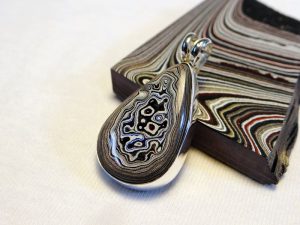
“There are 463 grams in a pound. Some people want to charge one or two dollars for each gram, which is crazy,” Hoeneise says of the demand.
While the name Fordite is most often associated with artifacts harvested from U.S.-based car plants, it does come from all parts of the world.
“Great Britain has some beautiful specimens that not only have the opaque colors, but metallic and transparency to some of the layers, too,” Madouse says.
Hoeneise adds that specimens she’s seen from Australia tend to have a plastic look to them. But collectors may appreciate rough from Down Under, featuring paint colors not used in the United States.
“The general process for the production of Fordite is the same. It’s the colors and quality that vary from one line to another.
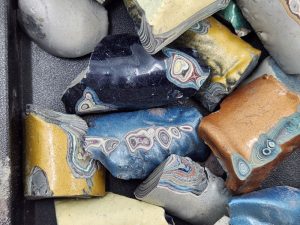
Some types take an amazing polish, while others tend to have a rougher surface when done. In addition, the colors can be different from manufacturer to manufacturer and often year to year within the same brand. It’s this variety that also reflects in the pricing of Fordite,” she says. “These are salvaged and recycled into beautiful creations and works of art.”
Conclusion: A Colorful Legacy Cast in Paint
Fordite is more than a man-made gemstone—it’s a vibrant slice of American industrial history, transformed into wearable art through ingenuity, nostalgia, and craftsmanship. From its accidental origins on the floors and walls of auto plants to its current status as a prized lapidary material, Fordite continues to inspire jewelers, collectors, and artists around the world. No two pieces are alike, and each one carries with it the colors, curves, and chemistry of a specific moment in automotive time. Whether you wear it, cut it, or collect it, Fordite proves that sometimes the most beautiful treasures come from the most unexpected places—just as Bob Ross said, “happy little accidents.”
This article about Fordite previously appeared in Rock & Gem magazine. Story by Sara Jordan-Heintz. Click here to subscribe.


